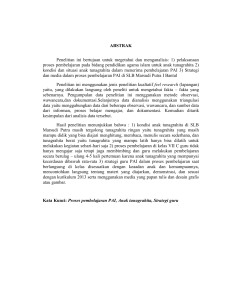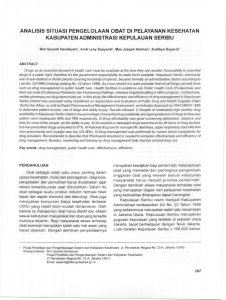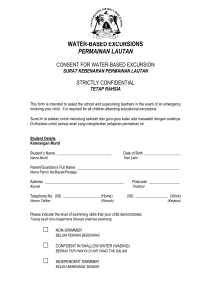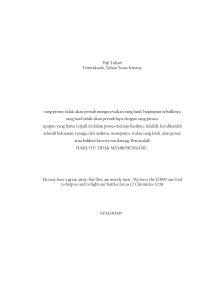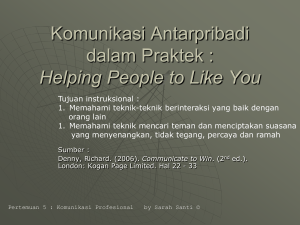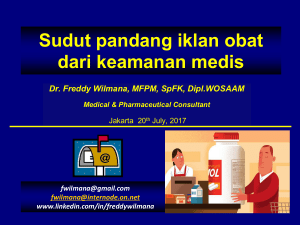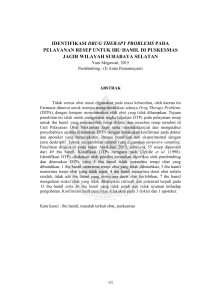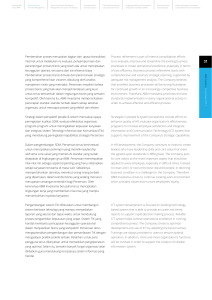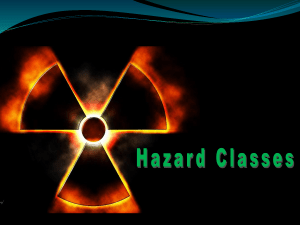The Basics of Healthcare Failure Mode and Effect Analysis
advertisement
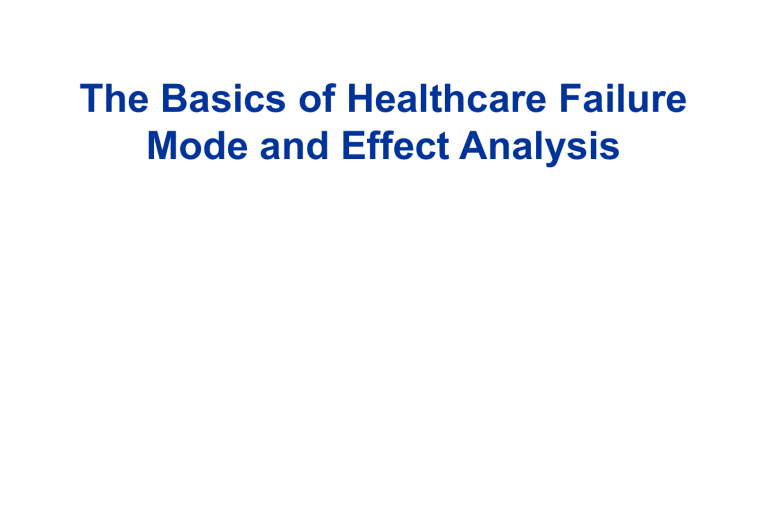
The Basics of Healthcare Failure Mode and Effect Analysis Failure Mode and Effect Analysis suatu methode yang sistematis untuk mengidentifikasi dan mencegah masalah hasil dan proses sebelum terjadi David M. Sine, CSP Director, Risk Assessment and Loss Prevention; Tenet HealthSystem Kegunaan HFMEA Dapat mengantisipasi pencegahan dari suatu kegagalan Tidak harus menunggu adanya pengalaman buruk/iterjadinya insiden Dapat menyusun sistem yang kurang berisiko terhadap kegagalan sistemik 3 FMEA digunakan secara luas dalam industri : Penerbangan Tenaga Nuklir Ruang angkasaAerospace Proses Industri Kimia Industri Automotive Food Processing (HACCP) sudah digunakan sejak lebih dari 30 tahun tujuan mencegah kegagalan sebelum terjadi 4 Rasionalisasi penggunaan FMEA dalam Pelayanan Kesehatan Latar Belakang Pencegahaan kecelakaan/insiden belum merupakan fokus utama dalam pengobatan di RS Adanya kesalahan persepsi dalam menilai “kesalahan kinerja ” dari tenaga kesehatan profesional Sistem RS yang kompleks tidak didisain untuk mencegah atau mengurangi kesalahan; lebih banyak perubahan yang reaktif, belum proaktif 5 Rasionalisasi penggunaan FMEA dalam Pelayanan Kesehatan Beberapa hal yang rentan terjadi dapat diketahui dan dicegah dengan penggunaan FMEA : Kegagalan tenaga listrik di Center Medical Unit Kegagalan MRI Medical gas medis Medication error 6 Standar Akreditasi KARS 2012 PMKP 11 EP 1 Pimpinan rumah sakit menerapkan kerangka acuan manajemen risiko yang meliputi a) sampai f) yang dimuat di Maksud dan Tujuan. PMKP 11 EP 2 Paling sedikit setiap tahun rumah sakit melaksanakan dan mendokumentasikan penggunaan alat pengurangan-proaktifterhadap-risiko dalam salah satu prioritas proses risiko PMKP 11 EP 2 Berdasarkan analisis, pimpinan rumah sakit membuat rancang ulang dari proses yang mengandung risiko tinggi. 7 Program Manajemen Risiko • • • • • • identifikasi risiko; menetapkan prioritas risiko; pelaporan tentang risiko; manajemen risiko; investigasi KTD; dan Manajemen klaim-klaim yang terkait manajemen risiko analisis dari risiko menjadi unsur yang penting • Untuk mencegah terjadinya kegagalan proses KNC atau risiko tinggi lainnya • Mencegah terjadinya kejadian sentinel. • => alat/tools yang dapat digunakan secara proaktif melakukan analisis terhadap konsekuensi suatu kejadian yang berujung pada proses yang kritis dan risiko tinggi adalah FMEA (failure mode and effect analysis). • Rumah sakit dapat juga melakukan identifikasi dan menggunakan alat serupa untuk melakukan identifikasi dan mengurangi risiko, seperti analisis terhadap kelemahan yang mengandung bahaya. So, what are they saying? •Our systems are too complex to expect merely extraordinary people to perform perfectly •Simplify and standardize wherever possible •Computerization, automation, use forcing functions •Learn new skills Process mapping •Understand new fields Human Factors Safety Engineering •Measure performance to design goals •Accept that it isn’t a democracy 11 JCAHO Standard LD.5.2 Identifikasi dan tetapkan prioritas pada proses yang berisiko tinggi Pilih minimal satu proses yang berisiko tinggi setiap tahun Identifikasi modus kegagalan yang potensial Identifikasi setiap efek yang mungkin terjadi akibat modus kegagalan 12 JCAHO Standard LD.5.2 Lakukan rancang ulang proses untuk mengurangi risiko terjadinya modus kegagalan untuk melindungi pasien dari efek tsb Lakukan uji coba dan laksanakan rancang ulan tersebut Identifikasi alat ukur /indikator dan lakukan pengukuran thd efektifitasnya iImplementasikan suatu strategi untuk mempertahankan effectifitas dari proses rancang ulang secara berkesinambungan 13 FMEA • Best applied to devices, products, components • Considers “detectability” • Criticality and frequency considered separately vs. HFMEAtm • Best applied to systems and human factors • “Detectability” not emphasized • Criticality combination of severity and frequency 14 HFMEAtm and the RCA Process 15 Healthcare FMEA Definitions Healthcare Failure Mode & Effect Analysis (HFMEAtm): (1) sebuah asesmen prospektif yang dapat mengidentifikasi dan memperbaiki langkah2 dalam sebuah proses secara rasional untuk menjamin hasil yang aman dan diharapkan secara klinis (2) A systematic approach to identify and prevent product and process problems before they occur. 16 Definisi Healthcare FMEA Effective Control Measure: Suatu barrier yang dapat menghilangkan atau mengurangi kemungkinan terjadinya bahaya/kejadian yang berbahaya Hazard Analysis (HA): suatu process of pengumpulan dan evalusi informasi dari kejadian berbahaya yang berhubungan dengan proses yang dipilih. Tujuan analisis bahaya (HA) adalah untuk mendapatkan Daftar kejadian berbahaya yang signifikan / dapat diterima secararasional tentang hubungannya dengan terjadinya Kecelakaan /kesakitan apabila tidak dikendalikan secara efektif Failure Mode: Berbagai cara untuk mengantisipasi kegagalan baik dalam proses maupun subproses 17 FMEA Hazard Scoring Matrix: A “Filter” Severity Probability Catastrophic Major Moderate Minor Frequent 16 12 8 4 Occasional 12 9 6 3 Uncommon 8 6 4 2 Remote 4 3 2 1 18 Hazard Analysis: Catastrophic Event (Traditional FMEA Rating of 10 – SEVERITY RATING: kegagalan dapat menyebabkan kematian atau kecacatan/kecelakaan Major Event Patient Outcome: Kematian atau kehilangan fungsi permanen (sensory, motor, physiologi, atau intelektual), bunuh diri, pemerkosaan, rx transfusi hemolytik, salah prosedur operasi (salah pasien/salah sisi) , bayi tertukar/diculik Visitor Outcome:kematian atau re hospitalisasi> 3x Staff Outcome: kematian atau re hospitalisasi> 3x * Equipment or facility: kerugian /kerusakan yang bernilai lebih dari 25.000.000 Fire:kebakaran yg tidak dapat diatasi Patient Outcome:Permanent lessening of bodily functioning (sensory, motor, physiologic, or intellectual), disfigurement, surgical intervention required, increased length of stay for 3 or more patients, increased level of care for 3 or more patients Visitor Outcome: Hospitalization of 1 or 2 visitors Staff Outcome: Hospitalization of 1 or 2 staff or 3 or more staff experiencing lost time or restricted duty injuries or illnesses Equipment or facility: **Damage equal to or more than $100,000 Fire: Not Applicable – See Moderate and Catastrophic (Traditional FMEA Rating of 7 – kegagalan menimbulkan derajat ketidak puana yang tinggi) 19 Hazard Analysis: SEVERITY RATING: Moderate Event (Traditional FMEA Rating of “4” – Failure can be overcome with modifications to the process or product, but there is minor performance loss.) Minor Event (Traditional FMEA Rating of “1”– Failure would not be noticeable to the customer and would not affect delivery of the service or product.) Patient Outcome: Increased length of stay or increased level of care for 1 or 2 patients Visitor Outcome: Evaluation and treatment for 1 or 2 visitors (less than hospitalization) Staff Outcome: Medical expenses, lost time or restricted duty injuries or illness for 1 or 2 staff Equipment or facility: **Damage more than $10,000 but less than $100,000 Fire: Incipient stage‡ or smaller Patients Outcome: No injury, nor increased length of stay nor increased level of care Visitor Outcome: Evaluated and no treatment required or refused treatment Staff Outcome: First aid treatment only with no lost time, nor restricted duty injuries nor illnesses Equipment or facility: **Damage less than $10,000 or loss of any utility♦ without adverse patient outcome (e.g. power, natural gas, electricity, water, communications, transport, heat/air conditioning). Fire: Not Applicable – See Moderate and Catastrophic 20 Hazard Analysis: PROBABILITY RATING: Frequent - Likely to occur immediately or within a short period (may happen several times in one year) Occasional - Probably will occur (may happen several times in 1 to 2 years) Uncommon - Possible to occur (may happen sometime in 2 to 5 years) Remote - Unlikely to occur (may happen sometime in 5 to 30 years) 21 HFMEAtm Decision Tree The HFMEA Decision Tree… Does this hazard involve a sufficient likelihood of occurrence and severity to warrant that it be controlled? (e.g. Hazard Score of 8 or higher) NO YES Is this a single point weakness in the process? (e.g. failure will result in system failure) (Criticality) NO YES Does an Effective Control Measure exist for the identified hazard? YES STOP NO Is the hazard so obvious and readily apparent that a control measure is not warranted? (Detectability) YES NO Design Countermeasure 22 Selecting Counter Measures MOST EFFECTIVE 1. Forcing functions (Poke Yoke) 2. Automation, computerization 3. Protocols and preprinted orders 4. Standardization (of equipment) 5. Checklists 6. Rules and double-checking 7. Education 8. Information LEAST EFFECTIVE 23 • Forms • Worksheets Hazard Scoring Matrix • Decision Tree The Healthcare Failure Modes and Effects Process Step 1- Select a Process Step 2 - Assemble the Team Step 3 - Graphically Describe the Process Step 4 - Conduct the Analysis Step 5 - Identify Actions and Outcome Measures 25 Healthcare FMEA Process STEP 1 Define the Scope of the HFMEA along with a clear definition of the process to be studied. 26 • • Step 1. Select the process you want to examine. Define the scope (Be specific and include a clear definition of the process or product to be studied). This HFMEA is focused on__________________________________________ _________________________________________________________________ _________________________________________________________________ _________________________________________________________________ _________________________________________________________________ _________________________________________________________________ _________________________________________________________________ _________________________________________________________________ _________________________________________________________________ _________________________________________________________________ Healthcare FMEA Process STEP 2 Assemble the Team – Multidisciplinary team with Subject Matter Expert(s) plus advisor 28 Step 2. Assemble the Team FMEA Number_____________ Date Started ________ Date Completed ________ • Team Members • 1.__________________ • 2.__________________ • 3.__________________ • 4.______________________ 5.______________________ 6.______________________ • Team Leader ____________________________________ Are all affected areas represented? YES / NO Are different levels and types of knowledge represented on the team? YES / NO Who will take minutes and maintain records?____________________________ Healthcare FMEA Process STEP 3 - Graphically Describe the Process A. Develop and Verify the Flow Diagram (what happens not what happened) B. Consecutively number each process step identified in the process flow diagram. C. If the process is complex identify the area of the process to focus on (apply arbitrary boundaries for a manageable bite) D. Identify all sub processes under each block of this flow diagram. Consecutively letter these sub-steps. E. Create a flow diagram composed of the sub processes. 30 Healthcare FMEA Process STEP 3 - Graphically Describe the Process 1 2 Penulisan resep Penerimaan resep 3 Penyiapan obat 4. Penyerahan obat 5 pemberian obat 31 STEP 3 - Graphically Describe the Process 1 penulisan resep • dr/drg menulis resep •resep secara lengkap termasuk Dosis dan rute obat suntuik 2.Penerimaan resep •Apotker melakukan telaah 6 benar •Apoteker mengkonfirmasi kpd dokter bila resep tidak ;engkap/tidak jelas •Hasil telaah diberikan kpd petugas penyiapan obat 3.Penyiapan obat 4.Penyerahan Obat • Petugas farmasi menyiapkan obat sesuai kebutuhan pasien • Konfirmasi rute dan dosis obat tidak dilakukan • Penulisan label tidak lengkap • Obat diberikan sejumlah resep • Obat diberikan sekaligus sesuai resep • Perawat itdak mengkonfirmasi kpd apoteker cara pemberian (rute dan dosis) 5. Pemberian obat •Perawat tidak mencocokan label dengan KIO •Perawat ruangan tidak memeriksa kelengkapan 6 benar dari obat yg diberikan Penulisan resep • Modus kegagalan • Tulisan tdk jelas • Umur dan berat badan tidak ditulis • Dosis dan rute obat tidak ditulis Penerimaan resep • Modus kegagalan • Apoteker tidak melakukan telaah 6 benar • Apoteker tidak mengkonfirmasi kepada dokter Penyiapan obat revisi Penulisan resep • Modus kegagalan • resep tidak terbaca Penerimaan resep • Modus kegagalan • Apoteker tidak melakukan telaah 6 benar • Apoteker tidak mengkonfirmasi kepada dokter Penyiapan obat Healthcare FMEA Process STEP 4 - Conduct a Hazard Analysis A. List Failure Modes (all the ways the process step could fail) B. Determine Severity & Probability (Filter) C. Use the Decision Tree (Proceed?) D. List all Failure Mode Causes 35 Hazard Analysis SEVERITY RATING: Catastrophic Event (Traditional FMEA Rating of 10 - Failure could cause death or injury) Major Event Patient Outcome:Death or major permanent loss of function (sensory, motor, physiologic, or intellectual), suicide, rape, hemolytic transfusion reaction, Surgery/procedure on the wrong patient or wrong body part, infant abduction or infant discharge to the wrong family Visitor Outcome: Death; or hospitalization of 3 or more. Staff Outcome: * A death or hospitalization of 3 or more staff Equipment or facility: **Damage equal to or more than $250,000 Fire: Any fire that grows larger than an incipient Patient Outcome:Permanent lessening of bodily functioning (sensory, motor, physiologic, or intellectual), disfigurement, surgical intervention required, increased length of stay for 3 or more patients, increased level of care for 3 or more patients Visitor Outcome: Hospitalization of 1 or 2 visitors Staff Outcome: Hospitalization of 1 or 2 staff or 3 or more staff experiencing lost time or restricted duty injuries or illnesses Equipment or facility: **Damage equal to or more than $100,000 Fire: Not Applicable – See Moderate and Catastrophic (Traditional FMEA Rating of 7 – Failure causes a high degree of customer dissatisfaction.) 37 Hazard Analysis SEVERITY RATING: Moderate Event (Traditional FMEA Rating of “4” – Failure can be overcome with modifications to the process or product, but there is minor performance loss.) Minor Event (Traditional FMEA Rating of “1”– Failure would not be noticeable to the customer and would not affect delivery of the service or product.) Patient Outcome: Increased length of stay or increased level of care for 1 or 2 patients Visitor Outcome: Evaluation and treatment for 1 or 2 visitors (less than hospitalization) Staff Outcome: Medical expenses, lost time or restricted duty injuries or illness for 1 or 2 staff Equipment or facility: **Damage more than $10,000 but less than $100,000 Fire: Incipient stage‡ or smaller Patients Outcome: No injury, nor increased length of stay nor increased level of care Visitor Outcome: Evaluated and no treatment required or refused treatment Staff Outcome: First aid treatment only with no lost time, nor restricted duty injuries nor illnesses Equipment or facility: **Damage less than $10,000 or loss of any utility♦ without adverse patient outcome (e.g. power, natural gas, electricity, water, communications, transport, heat/air conditioning). Fire: Not Applicable – See Moderate and Catastrophic 38 Hazard Analysis PROBABILITY RATING: Frequent - Likely to occur immediately or within a short period (may happen several times in one year) Occasional - Probably will occur (may happen several times in 1 to 2 years) Uncommon - Possible to occur (may happen sometime in 2 to 5 years) Remote - Unlikely to occur (may happen sometime in 5 to 30 years) 39 HFMEAtm Hazard Scoring Matrix Severity Probability Catastrophic Major Moderate Minor Frequent 16 12 8 4 Occasional 12 9 6 3 Uncommon 8 6 4 2 Remote 4 3 2 1 40 HFMEAtm Decision Tree The HFMEA Decision Tree… Does this hazard involve a sufficient likelihood of occurrence and severity to warrant that it be controlled? (e.g. Hazard Score of 8 or higher) NO YES Is this a single point weakness in the process? (e.g. failure will result in system failure) (Criticality) NO YES Does an Effective Control Measure exist for the identified hazard? YES STOP NO Is the hazard so obvious and readily apparent that a control measure is not warranted? (Detectability) YES NO PROCEED 41 Healthcare FMEA Process STEP 5 - Actions and Outcome Measures A. Decide to “Eliminate,” “Control,” or “Accept” the failure mode cause. B. Describe an action for each failure mode cause that will eliminate or control it. C. Identify outcome measures that will be used to analyze and test the re-designed process. D. Identify a single, responsible individual by title to complete the recommended action. E. Indicate whether top management has concurred with the recommended actions 44

